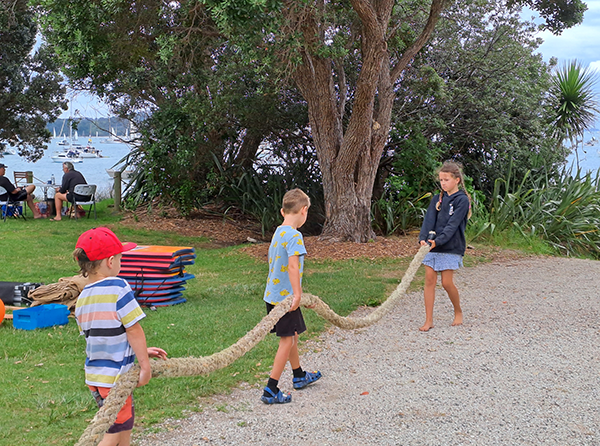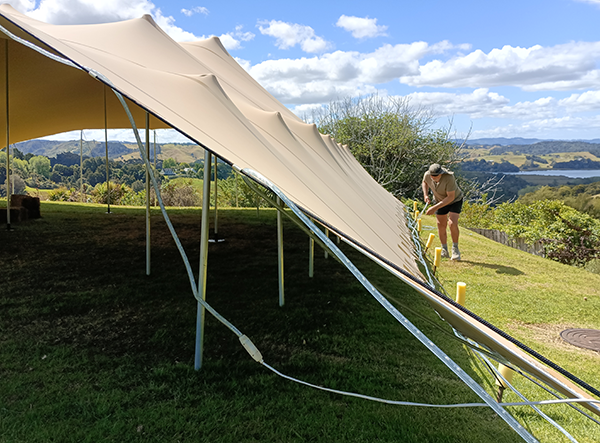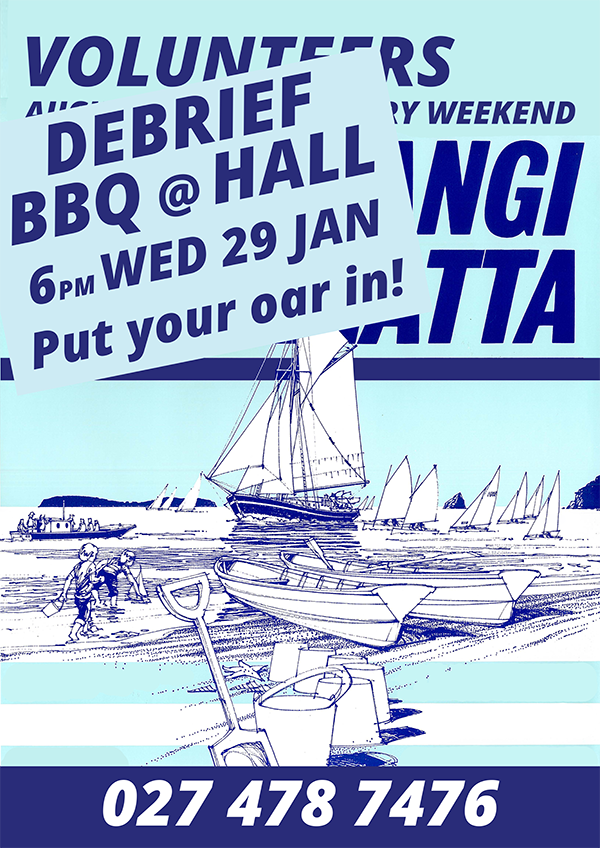Shoring up the Sullivans shoreside-regatta events
author Cimino 20250119

Sure Sign of Shoreside Leadership Genius: Asked which event they most wanted to be held first, the tug-of-war won hands down. A special prize was needed for the girl who, light-years ahead of her peers, spotted the most efficient—not-to-mention most fun and instructive—way of moving the monstrously heavy tug-of-war warp towards the beach was find one end and lead the way. A video of that playing out should commence every course on collaborative leadership, for time immemorial.
image Sarah Ransom
An abiding fondness almost immediately formed for it, after Mahurangi ActionMahurangi Action Incorporated: established 1974 as Friends of the Mahurangi revived the Mahurangi Regatta, in 1977. The good old-fashioned, leave-your-wallet-at-home picnic regatta is palpably heartwarming—the monetisation-free-zone ethos reflecting the fact that the great majority of the founding committee had been marked for life by the Great Depression.
For most part of its 48-year revival, Mahurangi Regatta planning and volunteer mustering has been the epitome of well-tested procedure, well-thumbed regatta manual and all. Alas, the privations of the pandemic and late-2024 predations upon the acting shoreside-events director left little in place—aside from event funding and permit—for the band of local heroes who have cheerfully and deftly picked up the pieces.
One piece, however, proved to be too heavy to pick up, at short notice: the hugely popular after-match prize-giving dance, up-harbour at Scotts Landing. Held in 2004 as a one-off, as the grand finale of Warkworth’s 150th celebrations, it was 1977 all over again—Mahurangi Action had had by the tail, another tiger of its own creation. Never mind sorting out the men from the boys, what was instantly obvious was that this is what regatta woman wanted all along: dancing. Including in the abandoned spirit of the juke joints that gave humanity jazz, blues, and rock, dancing is a deeply civilising element. The prize-giving dance instantly transformed the former boozy-blokey after-match function into an entirely family-friendly affair.
Family-friendly the after-match dance might be, but its financing and organising has come with lashings of risk, and flagellation. Ironically, with the purchase of the Mahurangi Harbour community marquee ahead of the 2024 regatta, the most problematic component had been permanently parked. The event had always been constructed so that it was immune the financial ruin if hit by unfavourable weather. The low-pressure system brewing as the article is being written is a brutal reminder of how inherently vulnerable outdoor events are—the professional brought in to organise the 2004 Mahurangi Regatta Ball swore off outdoor-event organisation henceforth, when the only thing that threatened, that evening, was a fresh breeze. Be that as it may, at a week out, the weather forecast for the regatta evening would have been more than encouraging, to confirm the booking of the West City Jazz Orchestra and sign up the last few stalwarts to throw up the marquee, next Friday.

First Wedding to Help Fund Mahurangi Harbour Community Marquee: First on the job, this year’s regatta organiser Kevin Finn beginning the process of taking down the marquee that was purchased immediately ahead of last year’s Mahurangi Regatta Prize-Giving Dance. Pictured in the background—second from the left—in the previous image, Kevin, resting between regatta duties, blissfully ignorant of the fact he would be running the show, the following year.
image Mahurangi Magazine
Alas and alack, while funding obtained from Auckland Council’s ever-supportive regional events fund will cover core regatta costs, even with a free marquee, with no fresh sponsorship money to match that, Mahurangi Action was well short of the $11 000 needed for the jazz orchestra, lighting, and sound—of which only $3000 goes to the orchestra itself, the Mahurangi Regatta being one of its community-good gigs, not to mention it being the musicians’ most keenly anticipated annual performance. A promising concept, the brainchild of the former sponsor was commenced ahead of the 2024 event. This was for a group-of-sponsors approach, made up of Mahurangi marine industry businesses. First out of the blocks was Quayside Boatyard, located at the historic Wilson Cement Works. But while there was support-in-principle expressed by other marine-industry businesses, business confidence simply wasn’t sufficiently buoyant for the way-on that had been established, to be maintained.
Time having run out in which to secure the funding needed, the jazz orchestra was reluctantly stood down—leaving all hope for a resumption of the big-band era dance music as the defining quality of the Mahurangi Regatta Prize-Giving Dance to its appreciators to convincingly champion, over the ensuing 12 months. Such a campaign, like most human endeavours, will be complicated. In this case, the festering can that can longer be kicked down the road is the misapprehension that the Mahurangi Regatta has eaten the Auckland Anniversary Regatta’s lunch. Following its 1840 inception, Auckland’s anniversary regatta grew to legendary proportions, but by the 1970s, yachts and yachting had changed. Yachts had become more commodious, and their auxiliary engines given them greater range, allowing families to make the most of their last opportunity to cruise their beloved Hauraki Gulf, before the work and school year resumed in earnest. Curtailing that idyll mid-weekend, patently, increasingly went against the grain.
When it was first revived, Mahurangi Regatta was not held on its traditional Boxing Day day, but to a new, first-Saturday-with-a-favourable-tide-for-launching-small-boats formula. Devonport Yacht Club, meanwhile—and since 1966—had been racing to Mahurangi on the Saturday of Auckland’s anniversary weekend, but coincidentally with the Mahurangi Regatta revival, had moved its start time to the Friday evening. It took Friends of the MahurangiMahurangi Action Incorporated: established 1974 as Friends of the Mahurangi and race organiser Sandspit Yacht Club only until two years to embrace the obvious synergy and make the Saturday of Auckland Anniversary weekend its annual regatta day. Although the revived Mahurangi Regatta had been an instant hit, there is little doubt that Devonport Yacht Club’s night race to Mahurangi helped build its community of regulars, not least of all by allowing Mahurangi adherents to awake an extra morning in their favourite bolthole. To argue however, that a widespread reluctance to forgo awaking in the Mahurangi on the Monday morning has singularly destroyed the Auckland Anniversary Regatta is moot, particularly as there has been no attempt to recruit sailors in an updated means of celebrating the holiday…

Better-Late-Than-Never: Clearly more useful had been posted a month ago, but even now a regatta volunteers notice displayed at the Mahurangi West and Pukapuka road intersection—based on the historic poster—could muster a handful of very welcome extra hands, on Saturday…
image Mahurangi Magazine
While yachting, inescapably, was always by definition been somewhat of an elitist activity, the Auckland Anniversary Regatta had naval, working-class, and indigenous roots. It then morphed to become a wholesome hybrid of yachts and workboats, famously mullet boats and coastal scows. New Zealand’s working scows ruled, responsible for setting the most immense expanses of sailcloth—collectively and individually. The mullet-boat yachts that Auckland’s mullet boats morphed into became the monstrously manly New Zealand, more egalitarian equivalent of the evolved Cape Cod catboat, for example. Crewed by more hairy-arsed males than could be decently accommodated and bilge full of bottles of beer, they were the robust introduction to cruising for thousands until, by the 1980s, could barely be given away. In their spirit, and that of the scows, which failed to evolve as a popular yacht, a 2020s, uniquely New Zealand, gender-neutral racing and cruising craft deserves to evolve and to help catalyse, in time for the 200th anniversary of the first, and the beginning the next, great 200 years of Mahurangi–Makaurau annual regattas. Built in the image of the uniquely antipodean Great Lakes centreboard scows, but cheaply and durably of engineered prince-of-pines radiata, and prioritising that inescapable necessity of mixed-gender yachting—a civilised space for toileting and dressing, no child born in the region need ever again to be deprived of experiencing at least once in their lives, the glory of sail.
But returning to the decidedly unmegalomaniacal institution of the Mahurangi Regatta shoreside events at Sullivans Bay, on Saturday: Invariably guaranteeing a strenuously demanding day of the volunteers, the beach events never disappoint in the quantum of early memories produced for the young participants, or their selfless adult enablers. Involvement is an immeasurable privilege, and rare respite from a determinedly dystopian world.
Volunteer!—contact Kevin Finn phone number adjacent:
What time’s the tide? Michael Gordon built the Bullock Track home for his family in short order on his shore leave from his job as chief engineer on Union Steamship Company’s trans-Tasman roll-on-roll-off ships. Like many of Mahurangi Action’s best, Michael had a low tolerance for management by monthly committee meeting, typified, he observed, by every regatta deliberation beginning with someone asking:
What time’s the tide, on regatta day?
These were days when generally only professional mariners, and oyster farmers, owned a current tide almanac—most mortals obliged to await the one-page, layperson chart published pre-Christmas by the dailies of the day. Michael single-handedly planned the event based on what he’d already witnessed playing out at Sullivans Bay, and bothered no one unless he needed a question answered, and compiled the first ever Mahurangi Regatta manual as he went. Sometimes his off-shift preparations were interrupted when sea state or berthage shudder proved too much for the hard drive of his early personal computer.
No amount of preparation, however, was equal to the combination of the vagaries of volunteer staffing the summer-holiday effect. The delight and curse of living in a Mahurangi heaven-on-earth is that family and friends can descend with little or no warning, temporarily obliterating all recollection of earnest assurances given to regatta directors, before summer’s intoxication took hold, in the balm of the golden weather.
Regatta bottom-line :
With every successive weather forecast indicating that the rain won’t arrive before midnight on regatta day:
- more volunteers are needed on Saturday and, regardless,
- call Kevin Finn on +64 27 478 7476 and, if not for this Saturday, sign-up for 2026!



